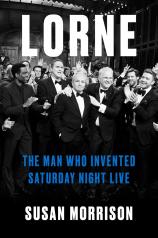Lorne: The Man Who Invented Saturday Night Live
Review
Lorne: The Man Who Invented Saturday Night Live
I’m writing this review on the morning after viewing the more than three hours of the “Saturday Night Live” 50th anniversary special, a delightful evening that revealed many of the strengths (and a few of the weaknesses) of this storied television franchise. As someone who watched the program’s debut on October 11, 1975 from my apartment in Ann Arbor, Michigan, and regularly since that time, I’m well-equipped to appreciate Susan Morrison’s LORNE: The Man Who Invented Saturday Night Live, a biography that’s both enlightening and entertaining.
Morrison, the articles editor of The New Yorker, approached Michaels about the project in 2015, and the detail that unfurls in the book’s 600 pages is a testament to her commitment to her task and the depth of her research. She also has at least a remote connection to Michaels’ career, having worked as an assistant to longtime “SNL” writer Jim Downey on “The New Show,” a Friday night spinoff that ran for a few months in 1984. While Morrison doesn’t airbrush Michaels’ shortcomings, she admits that he “generously opened the door” to her, and she responds in a spirit that is undeniably warm and sympathetic.
The book proceeds on parallel tracks. Each of its six parts leads off with an insider view of the making of an “SNL” episode --- in this case the one that aired on November 3, 2018, hosted by Jonah Hill, which earned him a coveted spot in the Five-Timers Club, along with luminaries like Tom Hanks, Steve Martin and Tina Fey. (Alec Baldwin currently holds the record at 17 host appearances.)
"...a biography that’s both enlightening and entertaining.... The balance of LORNE is a well-rounded portrait of its subject... Morrison dutifully chronicles the many ups and fewer downs of 'SNL' over its 50-year run..."
Anyone reading Morrison’s account --- comprising roughly 20 percent of the book --- will be impressed (and perhaps slightly bemused) at how a process that begins anew each week with the writers’ meeting on Monday somehow manages to culminate with the airing of a mostly live show six days later for 20 new episodes each season. By the end of the dress rehearsal that concludes at around 10pm on Saturday, the show typically runs 20-30 minutes long, and Michaels skillfully (and, of necessity, ruthlessly) orders cuts even as it airs. Along the way, he must manage the idiosyncratic talents and sometimes clashing egos of the people who deliver it to its audience.
The balance of LORNE is a well-rounded portrait of its subject --- born Lorne Lipowitz (he changed his name in 1967) to a middle-class Jewish family in Toronto (his Canadianness represents a subtle but important part of his identity) that wanted him to attend law school. As Morrison describes it, the sudden death of Michaels’ father at age 50, when he was 14, was one of the defining events in his life.
Morrison devotes ample attention to the roots of Michaels’ career as it moved from his partnership with fellow Canadian Hart Pomerantz (the two once wrote jokes for Woody Allen and Joan Rivers and hosted a show --- “The Hart and Lorne Terrific Hour” --- that ran on the CBC and was heavily influenced by the work of “Monty Python’s Flying Circus”) to Hollywood. There, Michaels developed his skills as a comedy writer on shows that included “Laugh-In” and Lily Tomlin comedy specials, all the while sharpening his vision for the project that became “SNL.”
As Morrison explains, it was always Michaels’ dream to produce films, which he was able to realize in 1992 --- only long after “SNL” became an established success --- with the production of Wayne’s World. But alongside that ambition, he wanted to produce a show that departed from what he saw as the stale format of popular network variety programs and embodied the counterculture sensibility of his generation. With the occasionally problematic support of NBC executive Dick Ebersol and the enthusiastic backing of NBC president Herb Schlosser, Michaels got that chance in the spring of 1975.
Morrison dutifully chronicles the many ups and fewer downs of “SNL” over its 50-year run (Michaels stepped away from it between 1980 and 1985). Loyal fans all have their view of the show’s golden age, and while it would be impossible over the course of more than 900 episodes not to produce his share of duds, Michaels has been the consistent, usually unflappable, presence who ensures that overall standard remains high.
One of his great gifts, in addition to a keen eye for on-air talent and, of equal or greater importance, great comic writing, has been his ability to reinvent the show while maintaining its essential formula. He likens its familiarity to a “Snickers bar: viewers expect a certain amount of peanuts, a certain amount of caramel, and a certain amount of chocolate.” It’s a recipe that has produced 103 Emmys in 50 years. But as Michaels likes to say, “The problem with making it look easy is that then people think it’s easy.”
Michaels celebrated his 80th birthday in November 2024. With houses in Amagansett, Long Island, St. Barts and 5,000 acres in Maine, where he cultivates organic blueberries, it would be easy to imagine him marking 50 years of “SNL” by signing off the air and entering a well-deserved retirement. In a recent profile, however, Maureen Dowd of the New York Times reported that, despite identifying some potential successors, “the reigning king is not currently considering abdicating.” That’s good news for longtime fans of the show like me, but that day inevitably will come. When it does, for all the reasons Susan Morrison makes clear, he’ll be assured an enduring place in entertainment history.
Reviewed by Harvey Freedenberg on February 21, 2025
Lorne: The Man Who Invented Saturday Night Live
- Publication Date: February 18, 2025
- Genres: Biography, Nonfiction
- Hardcover: 656 pages
- Publisher: Random House
- ISBN-10: 0812988876
- ISBN-13: 9780812988871




